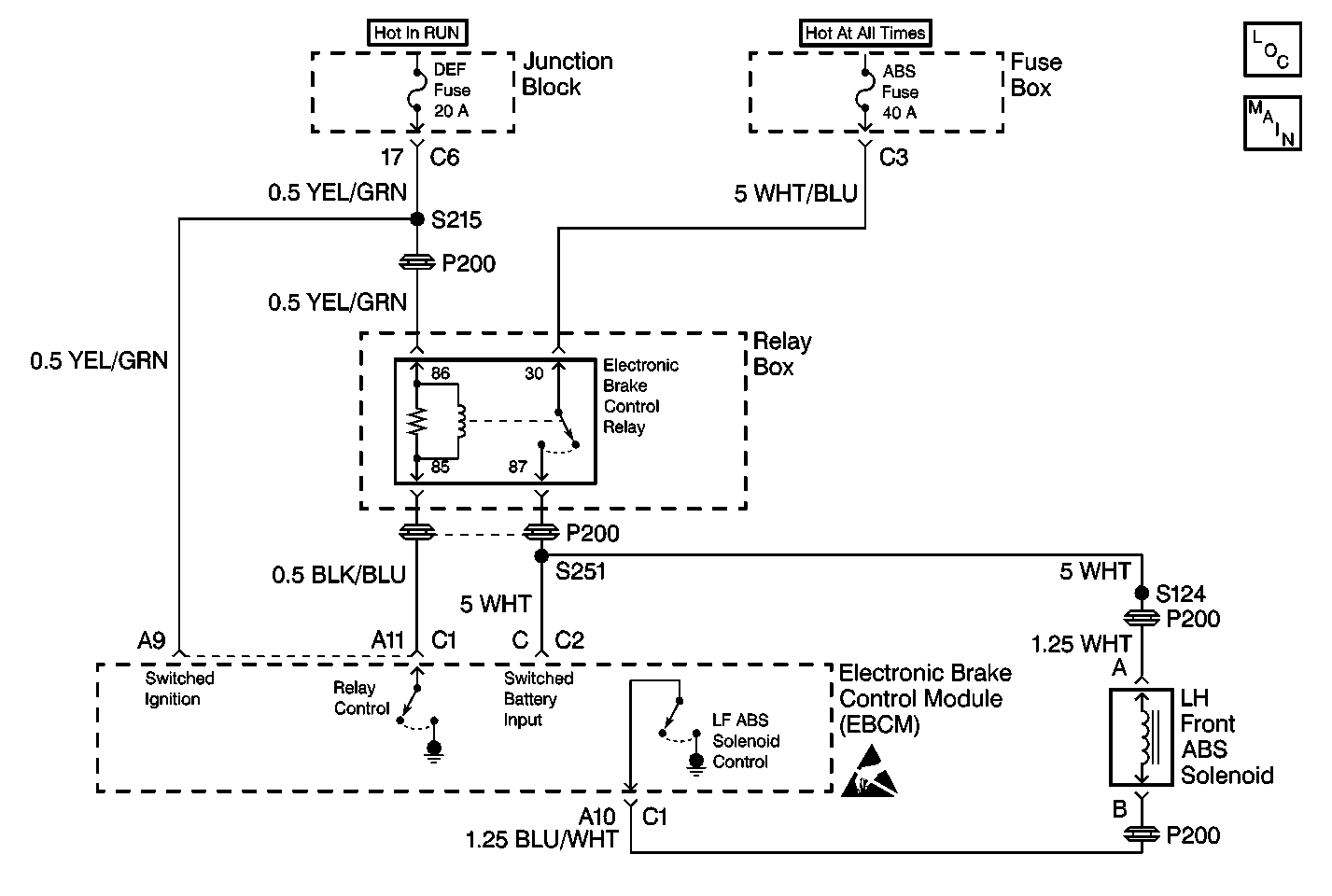
Circuit Description
This DTC identifies a solenoid that cannot be energized due to an open in its circuitry, or a solenoid that is always energized due to a short to ground in its circuitry between the EBCM and the solenoid.
An open will not allow proper ABS operation, but the short to ground simply turns ON the solenoid. A path for base brakes is still allowed once the motor rehomes and the check valve is lifted off its seat when the ignition switch is turned to ON.
Conditions for Setting the DTC
DTC C1276 can set only when the brake solenoid valve is commanded off while the Electronic Brake Control Relay is enabled.
A malfunction exists if the EBCM detects the left front brake solenoid valve control circuit voltage is not within specifications.
Action Taken When the DTC Sets
| • | A malfunction DTC stores. |
| • | The ABS disables. |
| • | The ABS warning indicator turns ON. |
Conditions for Clearing the DTC
| • | The condition responsible for setting the DTC no longer exists and the Scan Tool Clear DTCs function is used. |
| • | 100 drive cycles pass with no DTCs detected. A drive cycle consists of starting the vehicle, driving the vehicle over 16 km/h (10 mph), stopping and then turning the ignition OFF. |
Diagnostic Aids
The following conditions may cause an intermittent malfunction:
| • | A poor connection |
| • | Rubbed-through wire insulation |
| • | A broken wire inside the insulation |
Use the enhanced diagnostic function of the Scan Tool in order to measure the frequency of the malfunction.
Thoroughly inspect any circuitry that may cause the intermittent complaint for the following conditions:
| • | Backed out terminals |
| • | Improper mating |
| • | Broken locks |
| • | Improperly formed or damaged terminals |
| • | Poor terminal-to-wiring connections |
| • | Physical damage to the wiring harness |
Test Description
-
This test checks for a short to ground in the left front solenoid valve circuit.
-
This test checks for an open in the control circuit of the solenoid.
-
This test checks for a short to ground in the control circuit of the solenoid.
-
This test checks for an open in the battery feed circuit to the solenoid.
-
This test checks for an open in the left front solenoid valve.
-
This test determines if the malfunction is caused by the EBCM.
Step | Action | Value(s) | Yes | No |
|---|---|---|---|---|
|
Important: Zero the J 39200 test leads before making any resistance measurements. Refer to the J 39200 user's manual. | ||||
1 | Was the A Diagnostic System Check-ABS performed? | -- | ||
Is the resistance within the specified range? | OL (Infinite) | |||
Is the resistance within the specified range? | 0-2 ohms | |||
Is the resistance within the specified range? | OL (Infinite) | |||
Is the resistance within the specified range? | 0-2 ohms | |||
Use the J 39200 in order to measure the resistance between the LF ABS solenoid terminals A and B. Is the resistance within the specified range? | 2.5-5.0 ohms | |||
Did DTC C1276 set in the past three ignition cycles? | -- | |||
8 | Repair the short to ground in the BLU/WHT wire between the EBCM and the LF ABS solenoid. Refer to Wiring Repairs in Wiring Systems. Is the repair complete? | -- | -- | |
9 | Repair the open or high resistance in the BLU/WHT wire between the EBCM and the LF ABS solenoid. Refer to Wiring Repairs in Wiring Systems. Is the repair complete? | -- | -- | |
10 | Repair the open or high resistance in the WHT wire between the EBCM and the LF ABS solenoid. Refer to Wiring Repairs in Wiring Systems. Is the repair complete? | -- | -- | |
11 | Replace the LF ABS solenoid. Refer to Brake Solenoid Valve Replacement . Is the repair complete? | -- | -- | |
12 | Replace the EBCM. Refer to Electronic Brake Control Module Replacement . Is the replacement complete? | -- | -- | |
